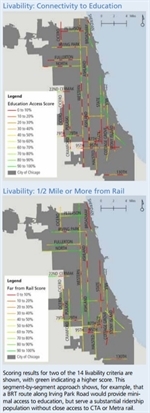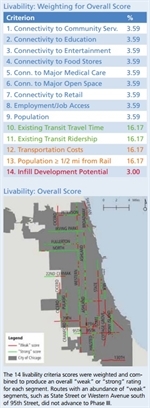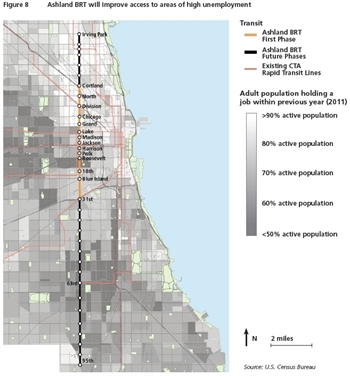
Bus Rapid Transit is one example of Inclusive Growth, the idea of planning with a diverse group of indicators in mind.

Click for larger image
Planning has changed over the decades and we must continually ask, “How are people living now? How does that affect future growth?” 50 years ago, the answer was city beautiful and superblocks. Today, our response must be more situational. Cue “Inclusive Growth.”
I was very grateful to attend last week’s discussion of Inclusive Growth hosted by the Organization for Economic Co-operation and Development (OECD) and the Ford Foundation at their headquarters in New York City. Both Ford and the OECD are grappling with how to affect growth that touches all points of the income spectrum. Merely measuring and driving GDP misses non-income related measures like health and educational attainment and overly focuses on the top earners of the country. Truly inclusive growth is multi-dimensional and advances multiple goals and objectives to benefit a wider swath of residents.
To plan inclusively necessitates many different viewpoints at the planning table—what OECD refers to as “multidimensionality.” Everyone has a vested interest in good planning in one way or the other: politicians, business people and people living in a community. Making sure each of these groups is represented at each stage of the process is key to plans that really work. So, how do you keep everyone focused and interested?

Click for larger image
Since its founding nearly 80 years ago, MPC has partnered with community, government and business sectors to build vibrant neighborhoods and a strong economy, develop quality housing and transportation solutions and manage our natural resources well.
For years, we've been connecting the dots between these diverse constituents and issues. This approach is at the heart of good planning and where inclusive growth fits right in.
The many dimensions of Inclusive Growth are one of its greatest strengths and have direct application in planning. By addressing multiple goals and advancing a broad based agenda you accomplish two key objectives:
- You create successful plans that are efficient, using limited resources to get the maximum return on effort; and,
- You develop a broad base of support that will keep all the necessary actors at the table to see the plans through to implementation.
Take planning for Bus Rapid Transit in Chicago, for example.
BRT certainly can move more people faster, addressing the classic, and singular, goal of mobility, but BRT can also connect students to schools, families to grocery stores, patients to hospitals etc. This approach is the newer transportation goal of “accessibility” and connects directly to Inclusive Growth’s goal of measuring non-economic terms and addressing “well-being.” How a transportation investment improves well-being of students, shoppers and patients is key.

Click for larger image
However, BRT in Chicago is also connecting residents of lower income communities with jobs in other parts of the city. The southern leg of the proposed Ashland BRT runs through one of the poorest parts of Chicago and connects its residents not only to jobs in the Loop, but also the Illinois Medical District, two of the top job centers in Chicago.
Good planning and Inclusive Growth share many attributes, from the multidimensionality that advances multiple goals to the broad base of engaged constituents that drive good plans to fruition. At the Metropolitan Planning Council we will continue to advance in the region and look forward to future engagement with Ford and OECD.